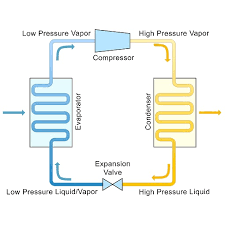All of the processes in the vapour compression refrigeration system, such as compression, condensation, expansion, and evaporation, are included in the vapour absorption refrigeration system. Ammonia, water, or lithium bromide are utilized as refrigerants in vapour absorption systems. In the condenser, the refrigerant is condensed, and in the evaporator, it is evaporated. The refrigerant cools the evaporator and then releases heat into the environment through the condenser.
The process of suction and compression of a refrigerant in the refrigeration cycle is the fundamental difference between the two systems. The compressor in a vapour compression system suctions the refrigerant from the evaporator and compresses it to high pressure. The compressor also allows the refrigerant to circulate throughout the refrigeration cycle. The absorber and the generator are two separate machines that perform the suction and compression processes in the vapour absorption cycle. In the vapour absorption cycle, the absorber and generator, therefore, take the position of the compressor. By absorbing the refrigerant, the absorbent allows it to pass from the absorber to the generator.
Another significant distinction between the vapour compression and vapour absorption cycles is how energy is delivered to the system. The energy input in the vapour compression system comes in the form of mechanical work from an electric motor that is powered by electricity. The energy input in the vapour absorption system is provided in the form of heat. This heat might come from the process’s surplus steam or hot water. Other sources of heat, such as natural gas, kerosene, and heaters, can also be used to generate heat, albeit they are only employed in small systems.
Simple Absorption System and How it Works?
1) Condenser: The refrigerant enters the evaporator at high pressure and temperature, much as it does in the classic vapour compression cycle condenser. The condenser is cooled by water.
2) Expansion valve or restriction: The pressure and temperature of the refrigerant drop dramatically as it travels through the expansion valve. The evaporator then receives the refrigerant (in this example, ammonia).
3) Evaporator: The refrigerant enters the evaporator at very low pressure and temperature, producing the cooling effect. This refrigerant is sucked by the compressor in the vapour compression cycle, but in the vapour absorption cycle, it flows to the absorber, which functions as the refrigeration cycle’s suction component.
4) Absorber: The absorber is a container made up of water as the absorbent and the previously absorbed refrigerant. As a result, the absorber is made up of a weak solution of the refrigerant (in this example, ammonia) and absorbent (water in this case). When evaporator ammonia enters the absorber, it is absorbed by the absorbent, lowering the pressure inside the absorber and allowing more refrigerant to flow from the evaporator to the absorber. Water absorbs less ammonia at high temperatures, thus it is cooled by an external coolant to boost its ammonia absorption capacity.
How Does Absorption Refrigeration Work? (Continued)
Because the vapour pressure of the refrigerant-absorbent in the absorber is lower than the vapour pressure of the refrigerant in the evaporator, the refrigerant flows from the evaporator to the absorber at first. The pressure on the low-pressure side of the system is determined by the vapour pressure of the refrigerant-absorbent inside the absorbent, as well as the refrigerant’s vaporizing temperature inside the evaporator. The type of the absorbent, its temperature, and concentration all influence the vapour pressure of the refrigerant-absorbent solution.


